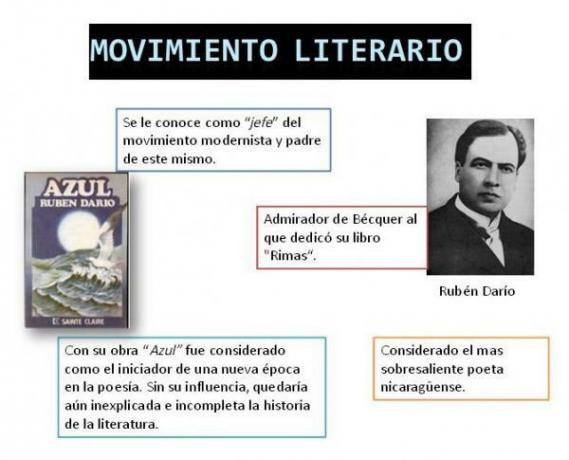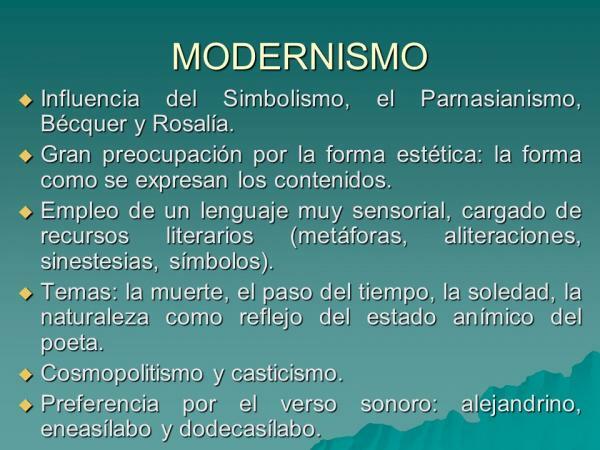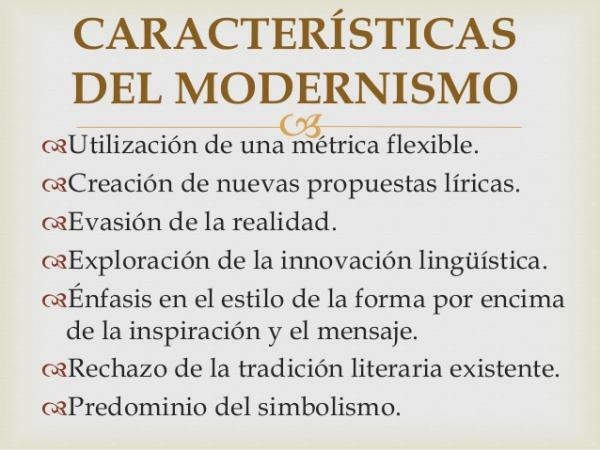The 9 CHARACTERISTICS of literary MODERNISM

Modernism was a cultural and literary movement that occurred among the 19th and 20th centuries and that had a strong repercussion in the Hispanic letters. This current represented a new way of understanding the arts and literature, thus opening the way to the new contemporary era. The maximum exponent of this movement was Ruben Dario with his collection of poems "Azul", a text that condenses the aesthetic ideas of Modernism where aesthetics are cultivated in a precious and highly cultured way. In this lesson from a TEACHER we are going to show you the characteristics of literary modernism so that you know better what this important movement consisted of in western literature.
Rubén Darío was the father of Modernism. This author published his collection of poems "Azul" in which he established the foundations of a new literary trend that was characterized by a refinement of aesthetics and forms. Literary Modernism is committed to a more cosmopolitan, cultured and creative artist who dared to renew language in a complete way. This is the first time that a Latin American author has influenced Spain, thus creating a new aesthetic model to follow.
This stream started in 1888 due to the publication of the aforementioned collection of poems by Darío and was characterized by showing poems with a very cultured language and where indigenous and American themes abounded. However, the taste for culture, art and the more cosmopolitan life were also very present in these creations that, in addition, also had an idealized vision of both love and the woman.
Nicaraguan poet Rubén Darío greatly influenced Hispanic letters since he opted for a new way of making literature that was much more modern (hence the name), open and careful.

Image: Fandom
Before entering fully to know the characteristics of literary Modernism it is important that we contextualize better this artistic movement to understand the causes of its appearance and why it had such an impact on the culture of the moment.
We must understand that we are in the nineteenth century, a time that drinks the consequences of industrialization and where the world has become a very materialistic place and where you live in a hurry and dedicate many hours to work. In this panorama, the artist of Modernism emerges to defend imagination, creativity and beauty in a world where machines have made the front pages of newspapers.
Industrialism caused interest in the fine arts and thought to wane to give step to a more productive society, more ambitious and, therefore, less interested in aesthetics and beauty. The modernist artist appears in front of this type of society where he is interest in art disappearing to make way for indifferent people.
It is difficult to clearly indicate the origin of Modernism since it is a current that, in its beginnings, is very related to the last blows of Romanticism literary. From this movement, Modernism takes advantage of some points such as the passion for art, the rebellious attitude of the artist, the defense of the imagination and feelings, and so on.
But the main difference is that Modernism, as its name suggests, appears with the aim of creating an artistic trend that faithfully reflect the historical moment that was being lived at the time. Therefore, we are not only facing a literary movement but we are facing a spiritual crisis in the West caused by the rise of capitalism and which made materialism triumph over humanism.

Image: Slideplayer
We will enter the bulk of this lesson and we will talk about the main characteristics of literary Modernism. Let us remember that this current defended "art for art's sake", that is, the creation of artistic works with the mere objective of enjoying them in an aesthetic and poetic way. Of all the literary genres, poetry was the favorite of the modernists because it allowed them to create images loaded with beauty and with great aesthetic force.
The importance of aesthetics
It is one of the most outstanding characteristics of literary Modernism. This current defends the taste for aesthetics for the mere pleasure of enjoying art and the most neat and careful language. The motto most defended by the modernists was that of the "art for art's sake", that is, not needing a rational or ideological motive to create the artistic work but simply for the sheer pleasure and delight of art.
Neat and very careful language
It is another of the most obvious characteristics of literary Modernism. And it is that the artists wanted to take a step further in their productions and, therefore, they created texts that had a very well kept language, delicately selected and loaded with rhetorical figures that would give a more poetic and cultured touch to the text. The search for formal perfection was a fate among modernists who wanted to show a high-quality work of art.
A multidisciplinary stream
Although in this lesson we are talking about literary Modernism, you should know that this current does not it only influenced in the field of letters but was also very important in other disciplines as the painting, drawing, architecture, etc.
Rejection of reality
We must also bear in mind that the rejection of Realism was a constant in this current because what he was looking for was to get away from everyday life to find beauty. Therefore, it is common for modernist poets to place themselves in bygone times or in exotic environments that allowed them to get away from reality. And why were they fleeing so much from reality? Basically because they did not like it, they were immersed in an industrialized world where there was no space for art and, therefore, escaped from this world to place themselves in other environments much more satisfactory.
Abundant preciousness
Another characteristic of literary Modernism is that in these works there is a clear tendency to create precious environments and images, loaded with the most classic beauty to satisfy that aesthetic need and pure artistic pleasure. For this reason, the writers worked to create a language loaded with beauty and with many literary resources that gave a more elaborate and elevated air to their creations.
Melancholic attitude
It is important to note that, due to this willingness to escape from your reality and take refuge in other worlds better, the attitude of the modernist poet always tended to have a melancholic and sad air. They were not comfortable in the world in which they lived and considered that in any other era they could have more fully enjoyed their talent and their art. The pessimism and decadence in society at the end of the century also took its toll on these artists.
Very musical poems
Modernist poets also used to create very beautiful poetic pieces both aesthetically and soundly. And, for that reason, they filled their creations with a musicality and a very specific rhythm that they could do with resources such as alliteration or synesthesia. In their texts they also used classical stanzas because these also had a great sound: the Alexandrine or the sonnet they were verses widely used among the modernists.
Influence of Greco-Roman mythology
Another characteristic of literary Modernism is that the poets were highly influenced by classical beliefs, especially in the field of mythology. It is for this reason that it is common to find references to the gods or myths of the culture of Ancient Greece that gave a more cultured and intellectual air to the poem.
Search for freedom
Like the romantics, the modernists also wanted to fight for creative freedom and break with the classical norms imposed by their predecessors. They rebelled against traditions and always wanted to find both artistic and literary novelties. Freshness abounds in his texts and we can even find experimental forms.

Image: Slideshare



